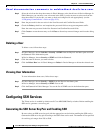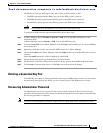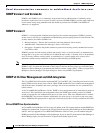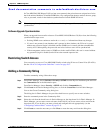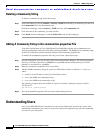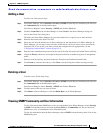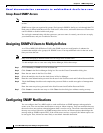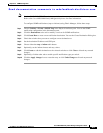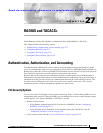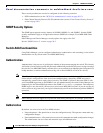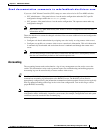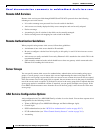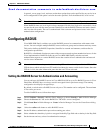
Send documentation comments to mdsfeedback-doc@cisco.com.
26-6
Cisco MDS 9000 Family Fabric Manager Configuration Guide
OL-6965-03, Cisco MDS SAN-OS Release 2.x
Chapter 26 SNMP Configuration
Assigning SNMPv3 Users to Multiple Roles
Group-Based SNMP Access
Note Because group is a standard SNMP term used industry-wide, we refer to role(s) as group(s) in this SNMP
section.
SNMP access rights are organized by groups. Each group in SNMP is similar to a role through the CLI.
Each group is defined with three accesses: read access, write access, and notification access. Each access
can be enabled or disabled within each group.
You can begin communicating with the agent once your user name is created, your roles are set up by
your administrator, and you are added to the roles.
Assigning SNMPv3 Users to Multiple Roles
As of Cisco MDS SAN-OS Release 2.0(1b), the SNMP server user configuration is enhanced to
accommodate multiple roles (groups) for SNMPv3 users. You map additional roles for the user at the
time you create the user.
Note Only users belonging to network-admin role can assign roles to other users.
To add multiple roles to a new user using Device Manager, follow these steps:
Step 1 Choose Security > SNMP and click the Users tab.
Step 2 Click Create in the Device Manager dialog box.You see the Create Communities dialog box.
Step 3 Enter the user name in the New User field.
Step 4 Select the multiple roles from the check boxes in Device Manager .
Step 5 Enter the same authentication password for the user in the New Password and Confirm Password fields.
Step 6 Check the Privacy check box and complete the password fields to enable encryption of management
traffic.
Enter the same new privacy password in the New Password and Confirm Password fields.
Step 7 Click Create to create the new entry or click Close close the dialog box without creating an entry.
Configuring SNMP Notifications
You can configure the Cisco MDS switch to send notifications to SNMP managers when particular
events occur. You can send these notifications as traps or inform requests. Traps are unreliable because
the receiver does not send any acknowledgment when it receives a trap. The sender cannot determine if
the trap was received. However, an SNMP manager that receives an inform request acknowledges the
message with an SNMP response PDU. If the sender never receives a response, the inform request can
be sent again. Thus, informs are more likely to reach their intended destination.



